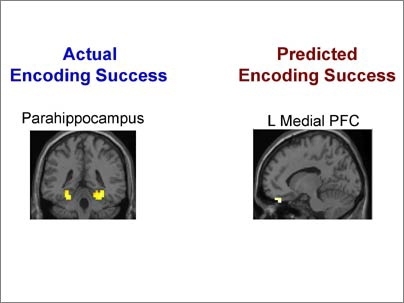Final exams loom, and you must review eight fact-laden textbook chapters and a binder full of class notes. Since you've made it to MIT, you probably know how to learn. A part of your mind seems to monitor your brain, telling you if you need to review a formula again, or if you know it cold, or if you could at least recognize it on a multiple-choice test.
But exactly where is that part of the mind?
It's right there above your eyes, in the ventromedial prefrontal cortex (VMPFC) of your brain. And it's quite a separate system from the medial temporal lobe (MTL), near your ear, that actually encodes facts in your memory.
That's what John Gabrieli, an associate member of the McGovern Institute at MIT, and his colleagues at Stanford University discovered in novel functional magnetic resonance imaging (fMRI) studies peering into the brains of 18 young adults performing learning tasks.
"We've known through psychological studies that the brain performs these two functions, encoding the memory and predicting whether the information will be later recalled," said Gabrieli, lead author of a study in the December issue of Nature Neuroscience. "But without these brain imaging studies, we might have thought they occurred in the same brain region. This is our first insight into the different brain mechanisms for memory and prediction, what psychologists call judgments of learning."
The fMRI studies showed that one specific brain region, the MTL, becomes very active when actually encoding facts in memory, while a quite separate region, the VMPFC, lights up when people predict whether they will later remember what they've learned. These two physically and functionally distinct circuits communicate with each other through the lateral and dorsal prefrontal cortex (LDPFC) at the outer end of the cortex.
Predicting is an important part of successful learning because it allows us to judge whether we've studied enough or need to review more, explained Gabrieli, who is also the director of the Martinos Imaging Center at the McGovern Institute and the Grover Hermann Professor of Health Sciences and Technology and Cognitive Sciences. People who make more accurate predictions are better learners and better students. Some people can intuitively judge their own memory; others must learn the skill. Gabrieli said he hopes that understanding more about the brain mechanisms involved in this type of introspection might help people become better learners.
Learning is just one example of how the "mind" can inspect its own content, he noted, and the VMPFC may be a key to the broader issue of self-awareness. Interestingly, the metal rod that pierced Phineas Gage's brain in 1848 obliterated the VMPFC, transforming a soft-spoken, dependable fellow into a loud-mouthed drifter with virtually no self-awareness.
Yun-Ching Kao and Emily Davis of Stanford contributed to this research. The study was conducted at Stanford with support from the National Institute of Mental Health/NIH.
A version of this article appeared in MIT Tech Talk on November 30, 2005 (download PDF).





